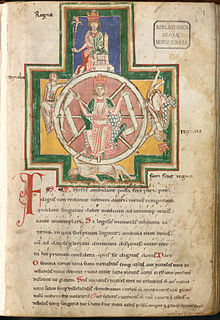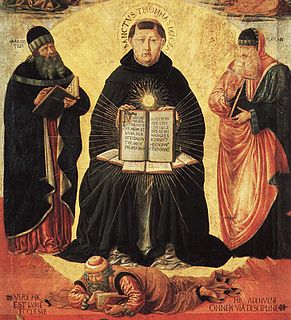 W
WArs cantus mensurabilis is a music theory treatise from the mid-13th century, c. 1250–1280 written by German music theorist Franco of Cologne The treatise was written shortly after De Mensurabili Musica, a treatise by Johannes de Garlandia, which summarised a set of six rhythmic modes in use at the time. In music written in rhythmic modes, the duration of a note could be determined only in context. Ars cantus mensurabilis was the first treatise to suggest that individual notes could have their own durations independent of context. This new rhythmic system was the foundation for mensural notation system and the ars nova style.
 W
WThe Book of Henryków is a Latin chronicle of the Cistercian abbey in Henryków in Lower Silesia. Originally created as a registry of belongings looted during the Mongol raids of 1241, with time it was extended to include the history of the monastery. It is notable as the earliest document to include a sentence written entirely in what can be interpreted as an Old Polish language. Currently the book is on exhibition in the Archdiocesan Museum in Wrocław. On October 9, 2015 the Book of Henryków was entered in the list of UNESCO's "Memory of the World".
 W
WCarmina Burana is a manuscript of 254 poems and dramatic texts mostly from the 11th or 12th century, although some are from the 13th century. The pieces are mostly bawdy, irreverent, and satirical. They were written principally in Medieval Latin, a few in Middle High German and old Arpitan. Some are macaronic, a mixture of Latin and German or French vernacular.
 W
WThe Chronica Majora has long been considered a contemporary attempt to present a universal history of the world. The Chronica is the seminal work of Matthew Paris, a member of the English Benedictine community of St Albans and long-celebrated historian. The work begins with Creation and contains annals down to the year of Matthew's death, 1259.
 W
WThe Chronica regia Coloniensis, also called the Annales Colonienses maximi, is an anonymous medieval Latin chronicle that covers the years 576 to 1202. The original chronicle only went up to 1197, but a continuator later added the following few years' events. According to the historian Manfred Groten, the Chronica was probably first compiled about 1177 in Michaelsberg Abbey, Siegburg, and then continued in Cologne. The earliest manuscript only contains an account down to 1175.
 W
WThe Chronica sancti Pantaleonis, also called the Annales sancti Panthaleonis Coloniensis maximi, is a medieval Latin universal history written at the Benedictine monastery of Saint Pantaleon in Cologne. It was written in 1237 and covers the history of the world in a series of annals from Creation down to the year of composition. A continuation down to 1249 was added later. Up to the year 1199 it relies heavily on other sources; from 1200 it is an independent source.
 W
WChronica seu originale regum et principum Poloniae, short name Chronica Polonorum, is a Latin history of Poland written by Wincenty Kadłubek between 1190 and 1208 CE. The work was probably commissioned by Casimir II of Poland. Consisting of four books, it describes Polish history.
 W
WThe Chronicles of the Kings of Mann and the Isles or Manx Chronicle is a medieval Latin manuscript relating the early history of the Isle of Man.
 W
WContra errores Graecorum, ad Urbanum IV Pontificem Maximum is a short treatise written in 1263 by Roman Catholic theologian Saint Thomas Aquinas as a contribution to Pope Urban's efforts at reunion with the Eastern Church. Aquinas wrote the treatise in 1263 while he was papal theologian and conventual lector in the Dominican studium at Orvieto after his first regency as professor of theology at the University of Paris which ended in 1259 and before he took up his duties in 1265 reforming the Dominican studium at Santa Sabina, the forerunner of the Pontifical University of Saint Thomas Aquinas, Angelicum, in Rome.
 W
WDe rebus Hispaniae or Historia gothica is a history of the Iberian peninsula written in Latin by Archbiship of Toledo Rodrigo Jiménez de Rada in the first half of the thirteenth century on behalf of King Ferdinand III of Castile.
 W
WDe sphaera mundi is a medieval introduction to the basic elements of astronomy written by Johannes de Sacrobosco c. 1230. Based heavily on Ptolemy's Almagest, and drawing additional ideas from Islamic astronomy, it was one of the most influential works of pre-Copernican astronomy in Europe.
 W
WThe Fleury Playbook is a medieval collection of Latin biblical dramas dating from around 1200 AD It was included in a composite volume of sermons, biblical texts, liturgical dramas, and hymns that was bound and kept at the library of Abbaye Saint Benoît de Fleury, a Benedictine monastery at Saint-Benoît-sur-Loire, France, until after the French Revolution and is now housed in the Bibliothèque de la Ville at Orléans, France. The works in the playbook are told in a musical style similar to that of plainsong. The origin of the book is unknown, but it is possible that it was written by multiple authors. The playbook consists of a total of 10 works, occupying pages 176–243 of the manuscript.
 W
WThe Flores Historiarum is the name of two different Latin chronicles by medieval English historians that were created in the 13th century, associated originally with the Abbey of St Albans.
 W
WThe Gesta comitum Barcinonensium et regum Aragoniae is a Latin chronicle composed in three stages by some monks of Santa Maria de Ripoll and recounting the reigns of the Counts of Barcelona from Wifred I (878–97) to James II (1291–1327), as late as 1299. It is the fawning history of the dynasty known as the House of Barcelona. In presenting the rulers of the county of Barcelona as the descendants of Charlemagne, the monks sought to justify their independent policy with respect to the King of France, their nominal sovereign. The Gesta is the chronological backbone.
 W
WThe Golden Legend is a collection of hagiographies by Jacobus de Varagine that was widely read in late medieval Europe. More than a thousand manuscripts of the text have survived. It was likely compiled around the years 1259–1266, although the text was added to over the centuries.
 W
WHistoria destructionis Troiae, also called Historia Troiana, is a Latin prose narrative written by Guido delle Colonne, a Sicilian author, in the early 13th century. Its main source was the Old French verse romance by Benoît de Sainte-Maure, Roman de Troie. The author claims that the bulk of the work was written in 71 days, from September 15 to November 25 of an unspecified year, with the full text being completed some time in 1287. As a result of this hasty composition, the work is sloppy at points and prone toward anacoluthon.
 W
WThe Historia Sicula is a chronicle and work written in Latin Medieval prose about the story of the Kingdom of Sicily and Kingdom of Naples, taking place between the years 1250 and 1293. The text was edited by Bartholomaeus of Neocastro. The work is important as it is the best known account of the Sicilian Vespers.
 W
WThe Kall-Rasmussen Fragment is a parchment page from c. 1275. It is one of the four fragments remaining, or early copy of, the original Saxo's Gesta Danorum. Its size is about 19x11cm. It consists of two pages with four written sides.
 W
WThe Lassen Fragment, is a parchment page from c. 1275. It is one of the four fragments remaining of the original, or early copy of, Saxo's Gesta Danorum. Size is 40x27 cm. It consists of one page with two written sides.
 W
WLiber Abaci is a historic 1202 Latin manuscript on arithmetic by Leonardo of Pisa, posthumously known as Fibonacci.
 W
WThe Livonian Chronicle of Henry is a document in Latin describing historic events in Livonia and surrounding areas from 1180 to 1227. It was written ca. 1229 by a priest named Henry. Apart from the few references in the Primary Chronicle compiled in Kievan Rus' in the twelfth century, it is the oldest known written document about the history of Estonia and Latvia.
 W
WThe Magnus Liber or Magnus liber organi, written in Latin, was a repertory of medieval music known as organum. The book was in use by the Notre-Dame school composers working in Paris around the end of the 12th and beginning of the 13th centuries. It is known from references to a "magnum volumen" by Johannes de Garlandia and to a "Magnus liber organi de graduali et antiphonario pro servitio divino" by the English music theorist known simply as Anonymous IV. Today it is known only from later manuscripts containing compositions named in Anonymous IV's description.
 W
WThe Opus Majus is the most important work of Roger Bacon. It was written in Medieval Latin, at the request of Pope Clement IV, to explain the work that Bacon had undertaken. The 878-page treatise ranges over all aspects of natural science, from grammar and logic to mathematics, physics, and philosophy. Bacon sent his work to the Pope in 1267. It was followed later the same year by a smaller second work, his Opus Minus, which was intended as an abstract or summary of the longer work, followed shortly by a third work, Opus Tertium, as a preliminary introduction to the other two.
 W
WOtia Imperialia is an early 13th-century encyclopedic work, the best known work of Gervase of Tilbury. It is an example of Speculum literature. Also known as the "Book of Marvels", it primarily concerns the three fields of history, geography, and physics, but its credibility has been questioned by numerous scholars including philosopher Gottfried Leibniz, who was alerted to the fact that it contains many mythological stories. Its manner of writing is perhaps because the work was written to provide entertainment to Holy Roman Emperor Otto IV. However, many scholars consider it a very important work in that it "recognizes the correctness of the papal claims in the conflict between Church and Empire." It was written between 1210 and 1214, although some give the dates as between 1209 and 1214 and numerous authors state it was published c.1211.
 W
WThe Plesner Fragment is a parchment page from c. 1275. It is one of the four fragments remaining, or early copy of, the original Saxo Gesta Danorum. Size is 15x13cm. It consists of one page with two written sides.
 W
WRegimen Animarum is a Latin codex that was written in 1343 for the Archbishop of Canterbury. It contains the Office of the Feast of Corpus Christi.
 W
WThe Summa contra Gentiles is one of the best-known treatises by St Thomas Aquinas, written as four books between 1259 and 1265.
 W
WThe Summa Grammatica was one of the earlier works on Latin grammar and Aristotelian logic by the medieval English philosopher Roger Bacon. It is primarily noteworthy for its exposition of a kind of universal grammar.
 W
WThe Summa Theologiae, as the best-known work of Thomas Aquinas, is a compendium of all of the main theological teachings of the Catholic Church, intended to be an instructional guide for theology students, including seminarians and the literate laity. Presenting the reasoning for almost all points of Christian theology in the West, topics of the Summa follow the following cycle: God; Creation, Man; Man's purpose; Christ; the Sacraments; and back to God.
 W
WThe Wielkopolska Chronicle is an anonymous medieval chronicle describing supposed history of Poland from legendary times up to the year 1273. It was written in Latin at the end of the 13th or the beginning of the 14th century.